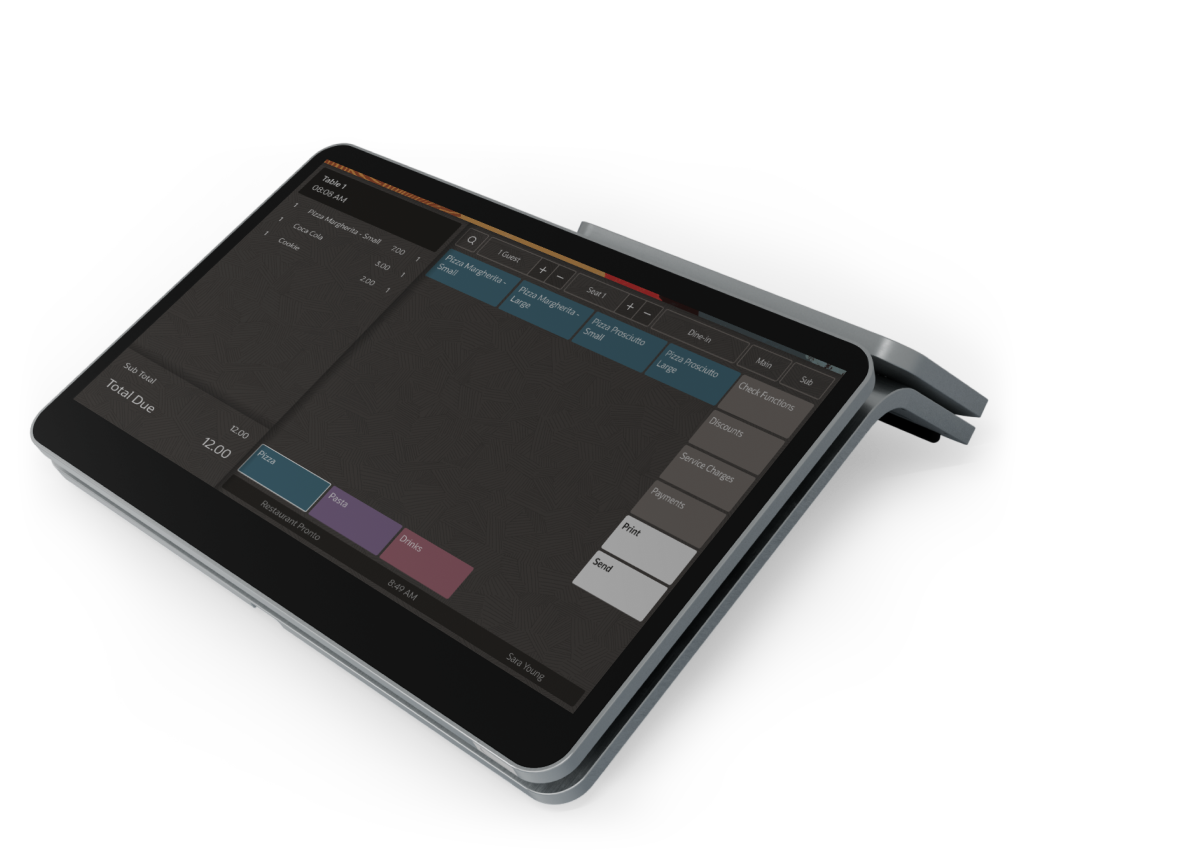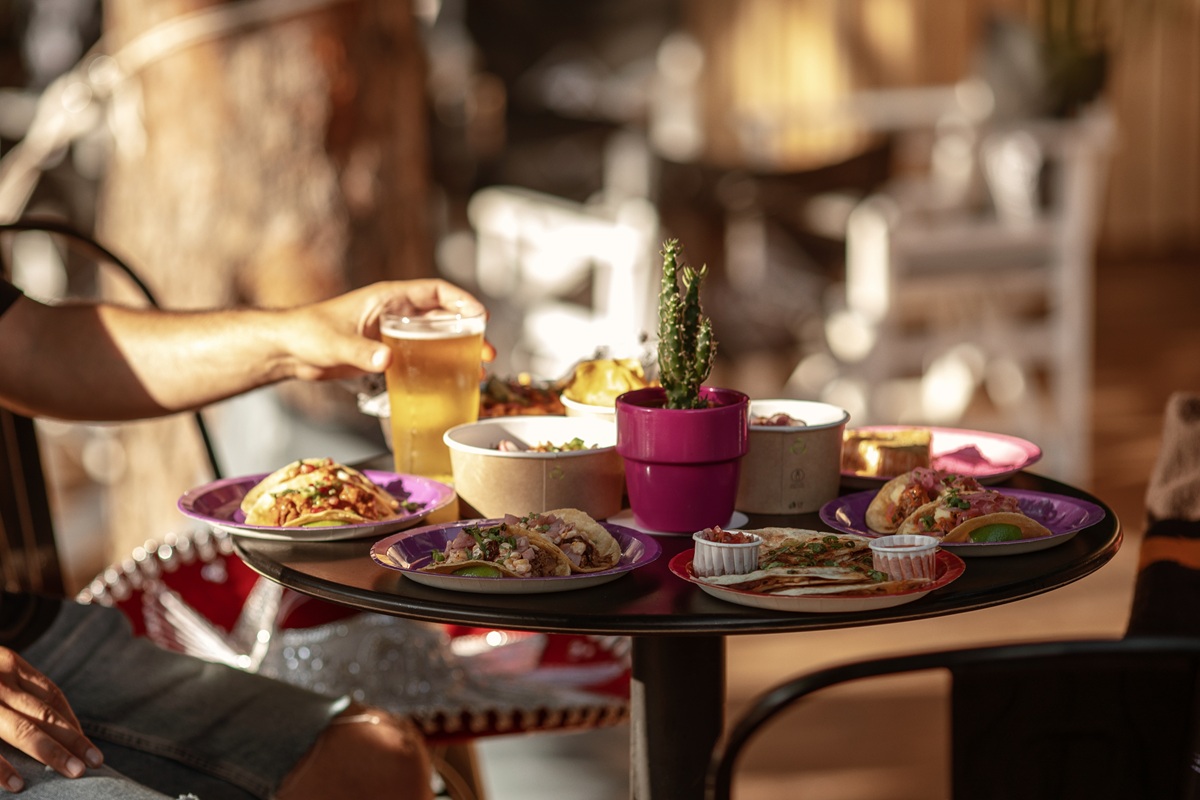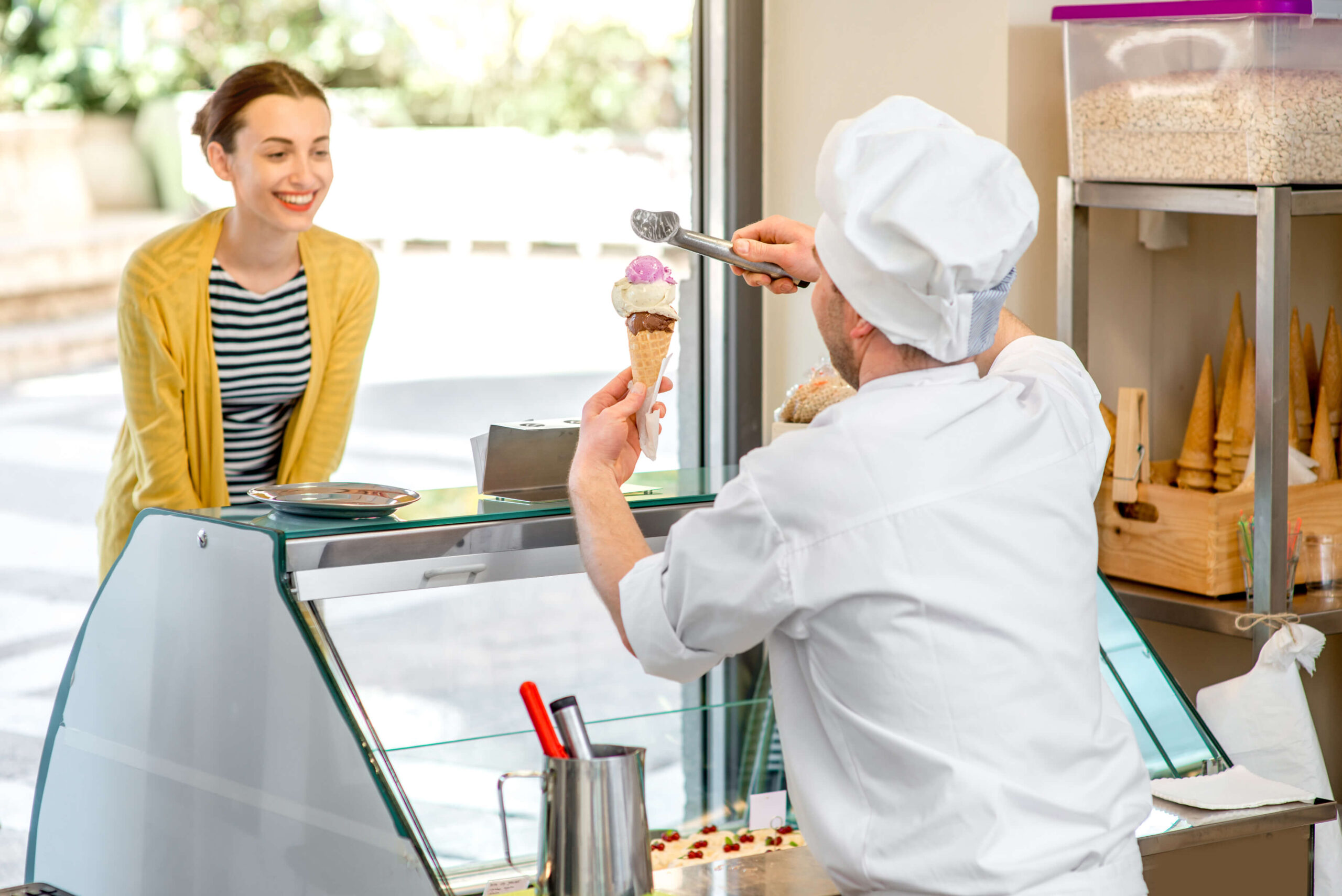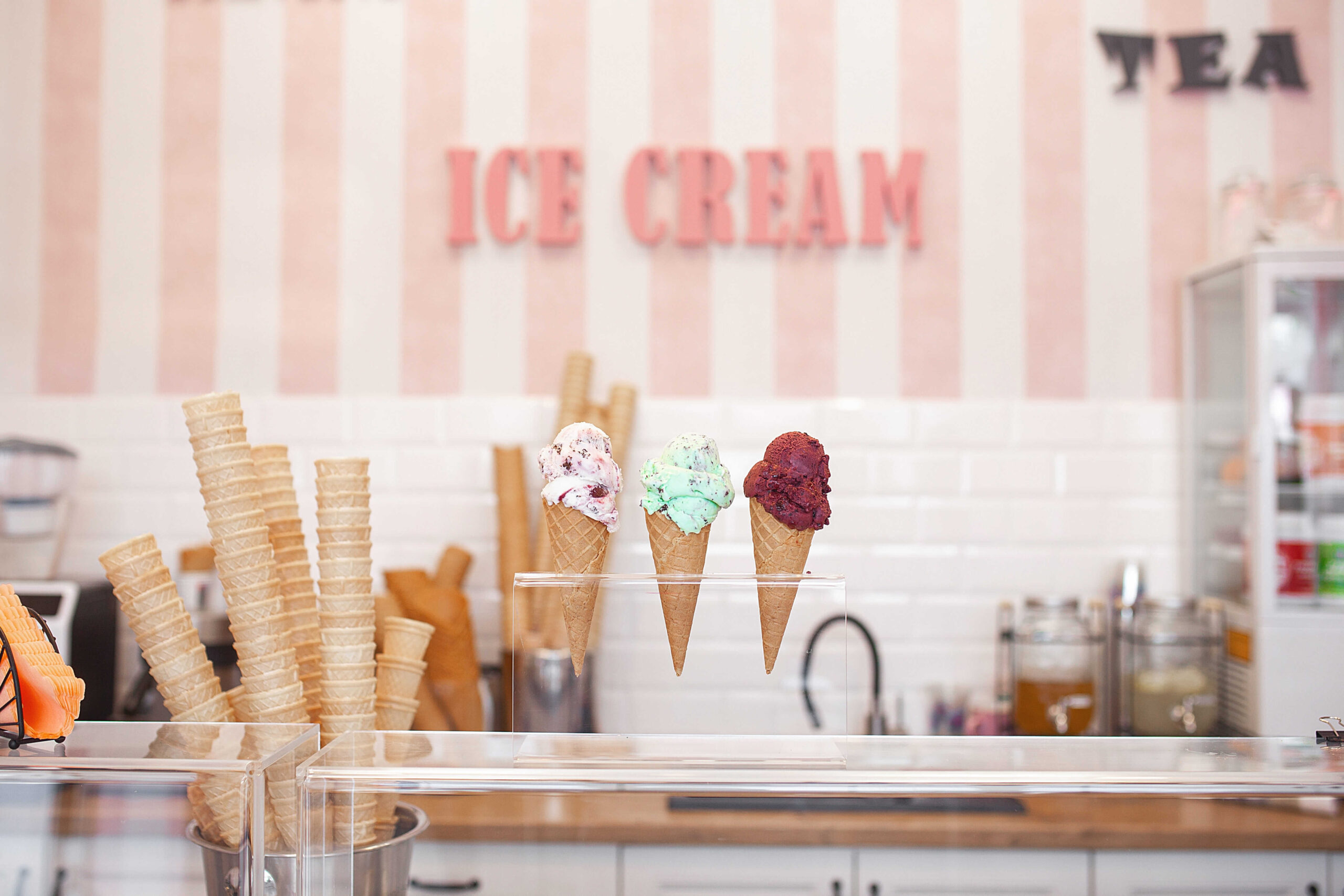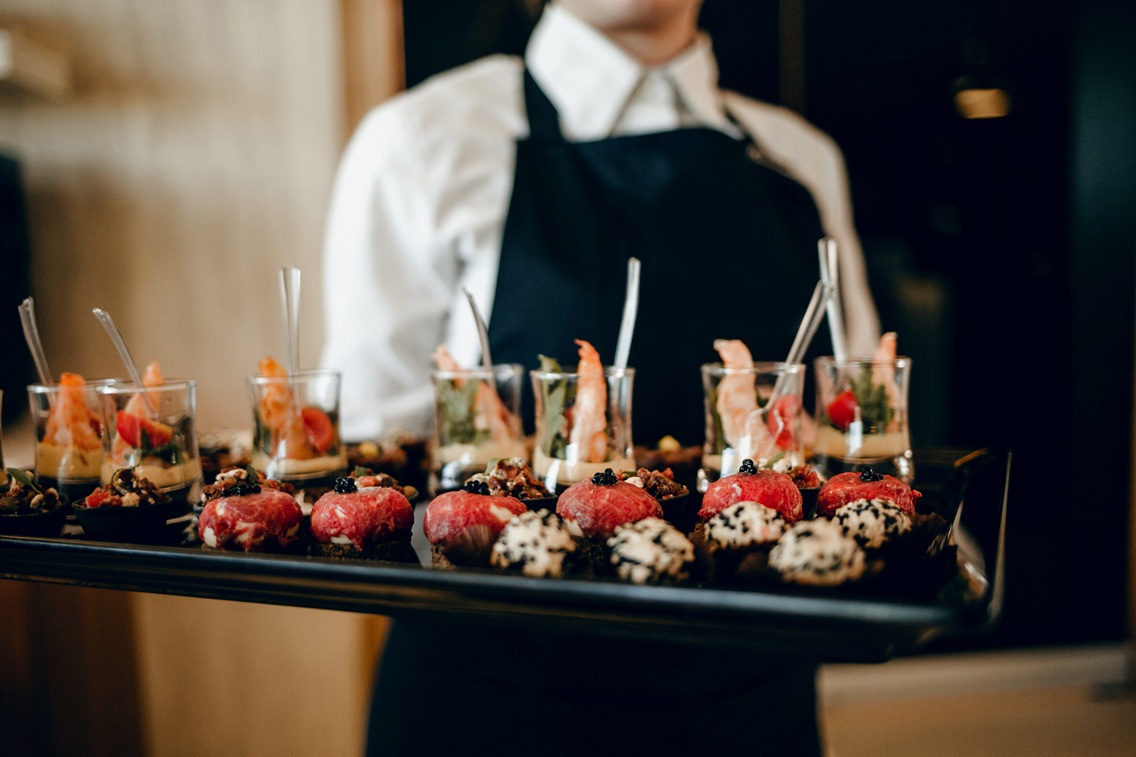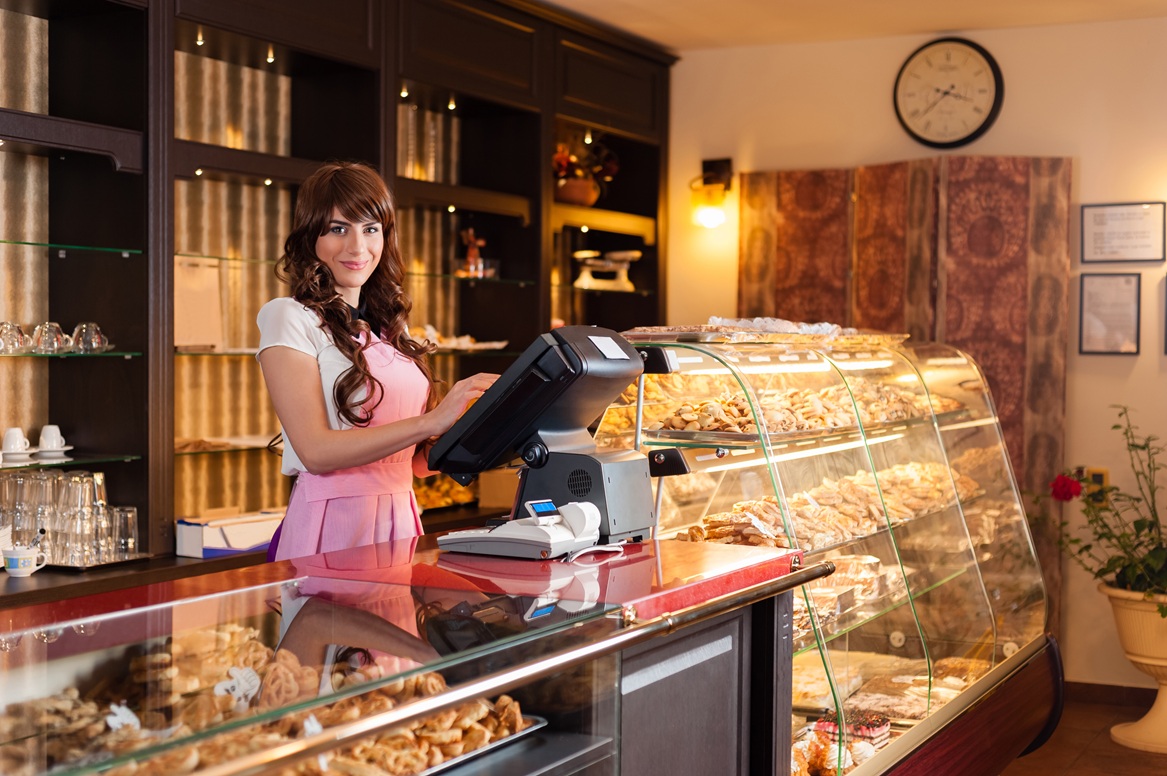To design the perfect ice cream shop floor plan, you must:
- prioritize customer flow by creating a clear path from ordering to pick up.
- ensure efficient staff operations by strategically placing the counter, kitchen, and storage.
- consider the customer experience by incorporating comfortable seating and brand-appropriate decor.
An ice cream parlor layout will reduce bottlenecks, increase sales, and keep customers coming back, while a poor layout can lead to frustrated customers and missed sales opportunities.
The ice cream shop floor plan you choose will shape how customers interact with your space and how efficiently your staff works. This directly translates to how much revenue your shop generates.
In today’s article, we will take a deep dive into how to create an ice cream floor plan that is sure to make your customers hearts melt.
Design intuitive customer flow: Position entrance, ordering counter, and POS system to guide customers naturally through your space without confusion or bottlenecks.
Prioritize accessibility and comfort: Ensure wide pathways, proper restroom placement, and diverse seating options to welcome all customers and encourage longer visits.
Create revenue-driving zones: Strategic placement of kitchen, POS stations, family areas, and outdoor seating directly impacts operational efficiency and sales potential.
Balance beauty with functionality: Use your floor plan as a branding tool while maintaining practical workflow that supports staff productivity during peak hours.
What is an ice cream shop floor plan?
An ice cream shop floor plan is the architectural blueprint or scaled layout of the shop’s interior and any outdoor areas. It determines how space is divided between the front of house and back of house.
The floor plan is a “map” of the shop drawn to scale so you can visualize the arrangement and flow of walls, aisles, and fixtures.
An ice cream shop floor plan takes into account:
- Visibility of the product display,
- Accessibility for staff and customers
- Compliance with health and safety regulations
Essential ice cream shop equipment, furniture and decor that you need to account for when designing the floor plan are:
- Ice cream display freezers for product visibility
- Countertops for service and point-of-sale areas
- Cash register or POS station,
- Prep tables
- Ingredient storage units
- Sinks (handwashing, dishwashing, and mop sinks)
- Refrigerated storage for ingredients
- Tables and chairs or booths
- Bar stools for counter seating
- Menu boards
- Lighting fixtures
- Decorative elements like wall art, plants, or shelving to enhance atmosphere
In larger shops, space should also be allocated for employee break areas, restrooms, and possibly an outdoor seating section, ensuring the overall layout is functional and inviting.
Why your ice cream shop floor plan matters
Your floor plan is the foundation of your shop’s daily operations. A good design helps you:
- Improve customer flow: so lines move quickly, and customers don’t feel cramped.
- Improve staff efficiency: by minimizing unnecessary steps between the prep area, freezer, and serving counter.
- Stay compliant with health and safety regulations: which require enough spacing, sanitation stations, and accessible walkways.
The main purpose of an ice cream shop floor plan is to ensure the layout supports smooth operations and a positive customer experience. A space that’s designed properly aligns with your shop’s concept (branding and style) and optimizes workflow.
Elements of a sample ice cream shop floor plan
Every successful ice cream shop begins with a blueprint that balances functionality and appeal. Let’s explore the essential components of an effective ice cream shop layout.
1. Ordering counter and POS placement
The heart of your ice cream shop is the ordering counter. Position it strategically to provide customers with an unobstructed view of your treats.
It is important for the area to be designed to prevent congestion and ensure a smooth flow of customers from entrance to exit.
Pay special attention to your ice cream shop POS system in your floor plan. Place it centrally where staff can easily access it, with enough space between terminals if you have several checkout points.
Some shop owners opt for self-ordering kiosks to speed up the process, especially during peak hours. The ideal arrangement has the cashiers at the end of the ordering counter, creating a natural flow from selection to payment.
In addition to the placement of the workstations, you should pay close attention to features that come with the POS system.
A good ice cream point of sale system should come equipped with:
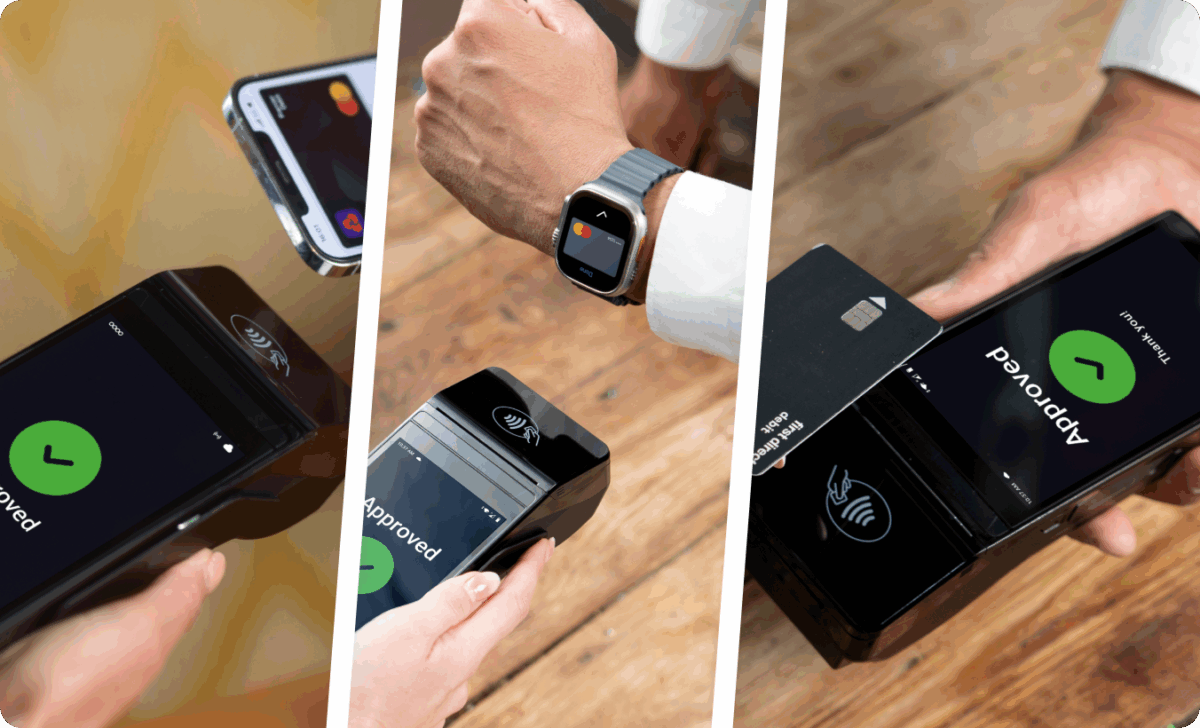
Offering a variety of restaurant payment options allows your customers to easily pay the bill at the counter or at the table.
Let your customers choose between cash, credit/debit cards, online wallets (Apple Pay/Google Pay), all while secure payment gateways and reputable payment processors ensure safe transactions.
Your menu editor should allow you the flexibility to:
-
- Add new categories, menu items, and add-ons
-
- Edit old categories, menu items, and add-ons
-
- Add photos and mouthwatering descriptions
-
- Change prices and product availability
Once you have made your change they should be automatically updated in your POS system.
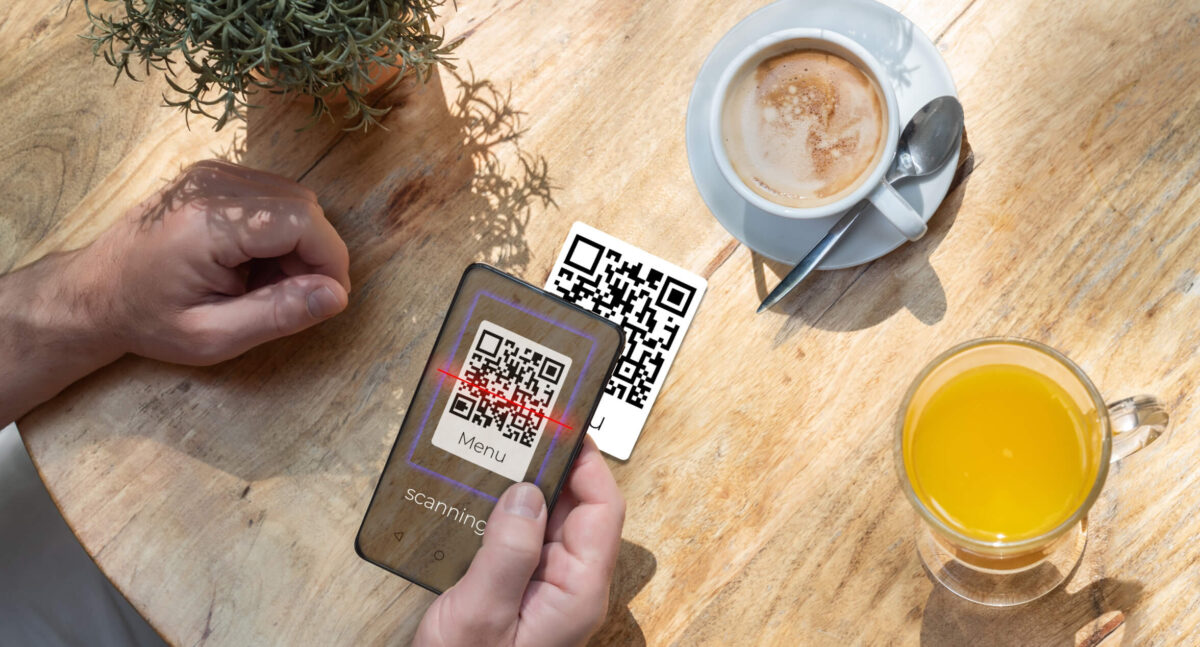
Upgrade your customers’ ordering experience by allowing them to order and pay directly on their smartphones, without waiting for a server.
This eliminates the need for physical menus, streamlines ordering, and can be managed through an online ordering system like GloriaFood.
Scoop Up More Sales with QR Code Ordering
Let customers browse your ice cream menu, order & pay without waiting in line
Create my QR code menuHaving printers in your FOH and BOH areas improves order accuracy by reducing errors caused by handwritten tickets.
Orders taken at the counter are instantly printed to their designated stations. This means that the clients’ orders will be fired fasted, thereby improving customer satisfaction.
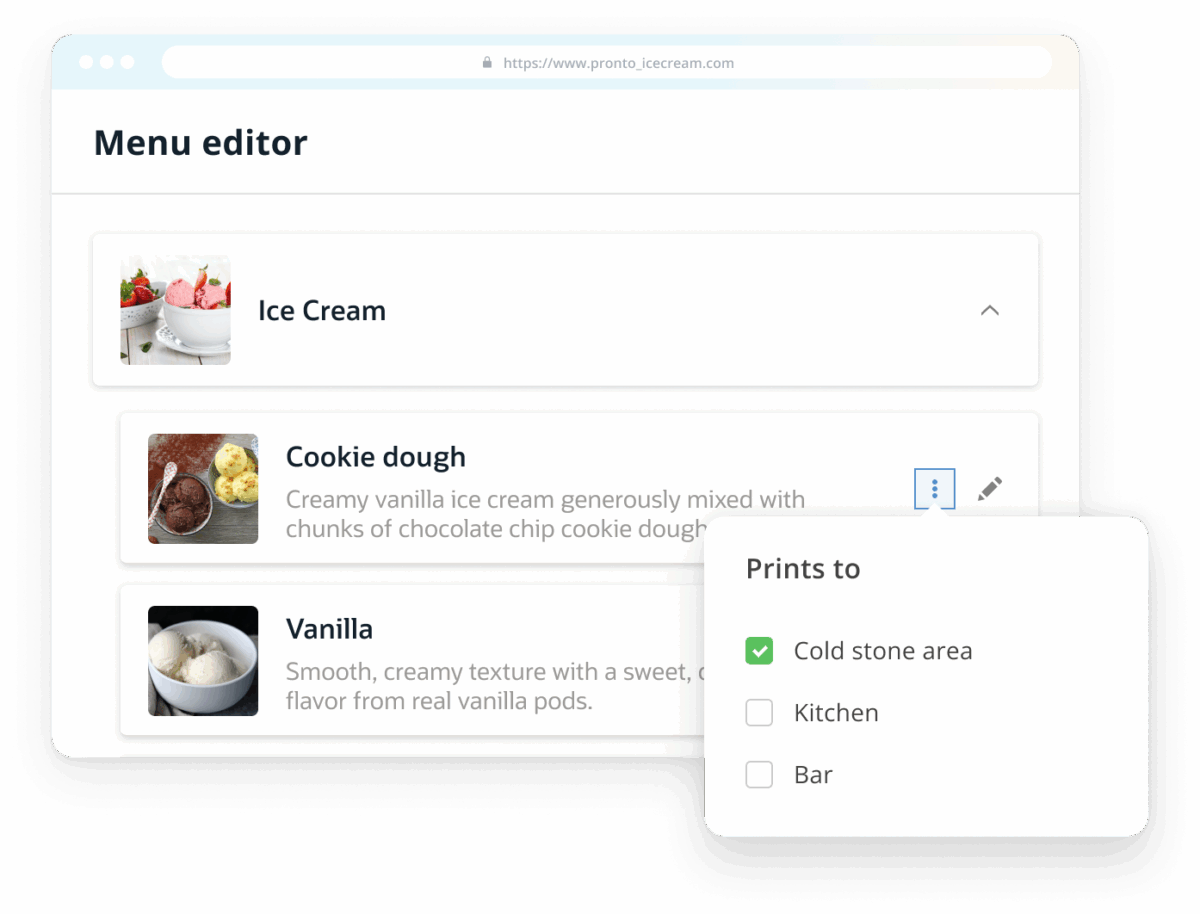
Perhaps the most quintessential part of every business open today is the ability to take orders online.
Adding an online ordering system allows you to expand your reach by opening new sales channels. This affords your customers the convenience to order from their homes using social media or your own ice cream shop website.
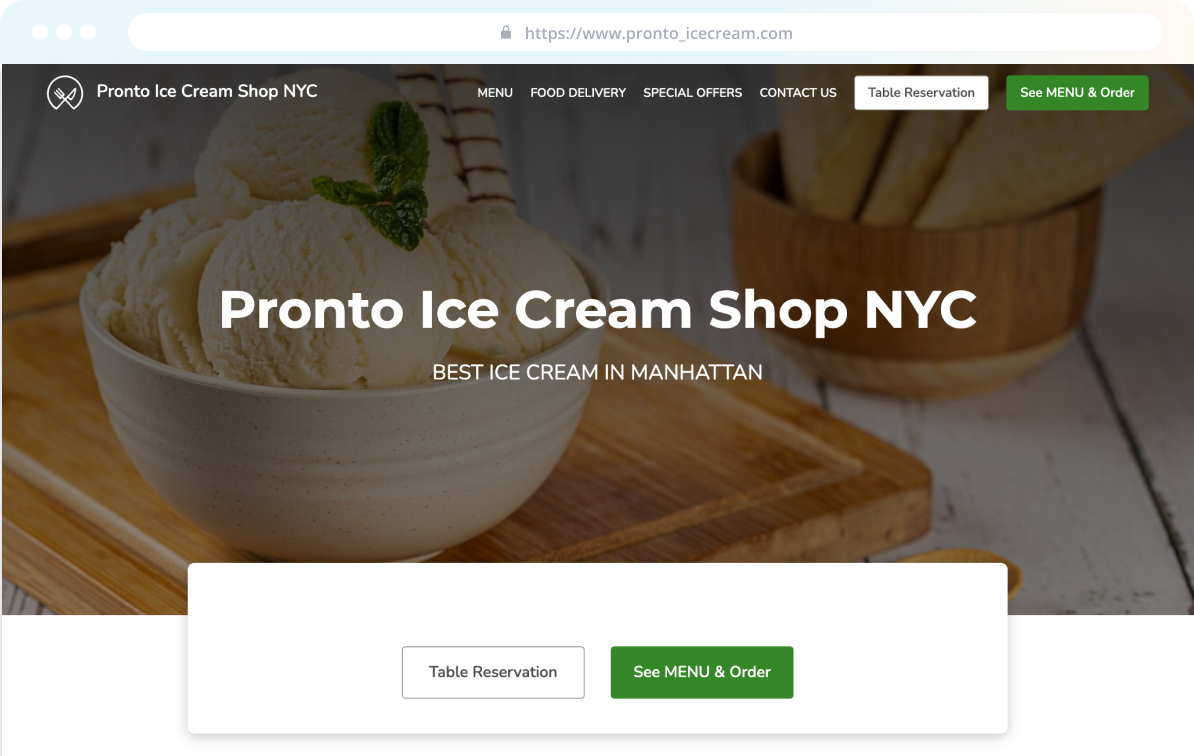
These reports provide you with valuable insights into your shop’s daily operations with the tap of a button. Find out in real time what changes need to be made to ensure your day is profitable. Some reports that should be included are:
-
- Property Financial report
- Employee Financial report
- Employee Open Check report
- Check Journal report
- Menu Item Sales reports
2. Kitchen and prep zones
Ice cream shops are typically smaller than full-service restaurants. This means you might have less space in your BOH area. Prioritize this space in your ice cream shop floor plan to accommodate:
- Storage areas for dry ingredients
- Prep stations with enough counter space
- Large ice cream equipment
- Inventory management area
- Dishwashing station
Think about including an open kitchen concept to allow customers to see your fresh preparation methods. This can boost their perception of quality and lead to more revenue.
3. Seating and waiting areas
Waiting areas prevent customers from feeling crowded, especially during peak seasons. Position this space near your POS location, to the end of your counter. This creates a natural flow between ordering and seating.
For seating zones, maintain some distance from the ordering line to create a relaxed atmosphere. This way, customers can enjoy their orders without disruption from new clients.
This separation helps control traffic patterns and enhances the overall experience. Many successful ice cream shops have different seating options from quick service to more comfortable lounge areas to accommodate various customer preferences.
4. Restrooms and staff rooms
Restrooms greatly influence customers’ choice of establishments, making them an important component of your ice cream shop floor plan.
These spaces should be designed to be accessible to everyone. Ensure doors and pathways are wide enough to accommodate wheelchairs and that appropriate grab bars are installed.
You should position restrooms where customers can easily reach them without passing through staff-only areas.
Staff areas should include dedicated break rooms and administrative spaces where employees can relax, and managers can handle paperwork. Consider making this dual purpose with tables suitable for meals and meetings.
How to create a blueprint for your ice cream shop
Now that you have your ideas written down, you’re ready to see them come to life. Here you have two options: use a floor plan software or hire a professional interior designer.
Floor plan software has made tremendous strides in recent years, allowing even the most novice users the ability to complete entire plan. Alternatively, you can enter your dimensions and requirements into a generative AI platform and allow it to do the heavy lifting for you.
Interior designers will work with you to get a general sense of what you want the “vibe” of your shop to be. They can help select the paint, furniture, and signage that reinforces your brand identity throughout the space.
It’s good to note that floor plan software and AI tools are significantly cheaper than interior designers. Some AI tools are free, and some software comes with free trails that allow you to download your ice cream shop blueprint.
Remember, your ice cream shop interior design influences customer moods and perceptions. A good blueprint should balance practicality with the visual appeal.
Always begin with operational requirements.
Incorporate your brand identity throughout your ice cream shop interior design ideas. Even the materials and textures you select communicate your values to customers.
Custom counters and display freezers featuring your logo create cohesive visual branding throughout the space.
Conclusion
An ice cream shop floor plan serves as the foundation for long term business success.
Remember each zone within your shop plays an important role in revenue generation.
Position your counters and POS systems in ways that guide natural customer flow. Kitchen areas can affect your employee’s productivity so arrange them in a manner that encourages them to go above and beyond.
Carefully thought-out seating arrangements, accessible restrooms, and family-friendly areas can transform first-time visitors into loyal customers.
Most importantly, your ice cream shop layout should feel welcoming to everyone who enters. Clear pathways, waiting areas, and accessible design elements create an environment where all customers feel welcome.
Start planning today, and watch your ice cream shop flourish through thoughtful, strategic design.
Create a space that sells more scoops
Improve customer flow and make every square meter work for you
Get StartedFrequently Asked Question
Epoxy flooring is a popular choice for dessert shops. Composed of a mixture of resin and hardener, epoxy creates a strong and seamless surface that can withstand heavy foot traffic, spills, and the rigorous demands of a busy kitchen environment.
Essential elements include:
- Ordering counter with strategically placed POS systems
- Organized kitchen and prep area
- Comfortable seating zones
- Accessible restrooms
- Clearly marked emergency exits
Consider also adding family friendly areas and outdoor seating if possible.
- Design wide traffic lanes to prevent bottlenecks
- Implement an intuitive customer flow from entrance to exit
- Consider adding QR code ordering
- Ensure adequate waiting space and use queue management techniques to reduce customer frustration during busy periods
- Design a cohesive visual identity: Choose a consistent color palette, logo, and font style that reflect the shop’s personality, whether it’s playful, vintage, or modern. Use these across signage, menus, packaging, and social media.
- Create signature flavors: Develop unique, branded ice cream flavors with memorable names that tie into your theme or brand story.
- Branded packaging: Use custom-printed cups, napkins, and spoons that display your logo and tagline. This reinforces your brand and increases visibility when customers take photos or carry their treats outside.
- Themed interior design: Decorate the shop to match your brand’s vibe. For example, a retro brand could feature checkered floors and neon lights, while a minimalist brand might use clean lines and neutral tones.
- Staff uniforms: Have employees wear branded attire to create a professional, unified look and strengthen brand recognition.
- Social media voice: Match your online tone with your brand personality. If your shop is fun and quirky, use playful language and emojis in your posts.
- Customer experience: Train staff to engage customers in a way that reflects your brand values, whether it’s friendly and fast or personalized and attentive.
Accessibility is important to ensure your business meets legal requirements and is open to all customers. Here are some accessibility tips you should implement:
- Ensure doorways are wide enough.
- Install grab bars in restrooms.
- Maintain wide pathways throughout the shop.
This complies with your local regulations and expands your potential customer base by welcoming all visitors.
A full-service ice cream shop with seating and a serving counter should ideally be between 800 and 1,200 square feet. This size allows for a comfortable customer experience and efficient staff operations. It also provides room for additional features like a toppings bar or specialty equipment.
To start an ice cream shop you need to:
- Develop an ice cream business plan
- Secure funding
- Obtain the necessary licenses and permits
- Find a high-traffic location
- Purchase commercial-grade equipment like freezers and dipping cabinets
- Source inventory (ice cream mix, toppings, cones, cups)
- Design an inviting space
- Create a delicious menu
- Implement marketing strategies to attract customers
Get your restaurant POS system
More than [[restaurants_number]] customers have advanced their restaurant businesses with GloriaFood
